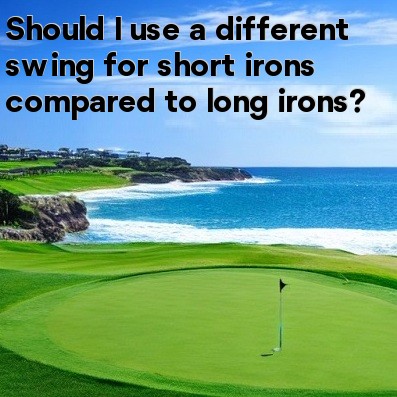
In golf, Should I use a different swing for short irons compared to long irons?
One question many golfers often ask is whether they should use a different swing for short irons compared to long irons. The answer is yes, and it is mainly due to the difference in the length and loft of the clubs.
Short irons:
Short irons refer to clubs with higher lofts, typically ranging from a pitching wedge (PW) to a 9-iron. These clubs provide a lower ball flight and are designed for shorter distances, typically around 100-150 yards. When using short irons, it is important to focus on generating a steeper angle of attack and more precision.
Here are some key points to keep in mind when swinging short irons:
- Ball position: Place the ball slightly back in your stance, closer to the center, to encourage a steeper angle of attack.
- Weight distribution: Keep your weight centered or slightly favoring your lead leg to promote a downward strike.
- Swing tempo: Maintain a controlled and smooth tempo throughout your swing to ensure accuracy.
Long irons:
Long irons, on the other hand, have lower lofts and are designed for longer distances, typically ranging from a 1-iron to a 4-iron or hybrid. These clubs require a different swing approach due to their longer shafts and smaller clubface sweet spots. When using long irons, the focus should be on generating distance and maximizing ball flight.
Consider the following points when swinging long irons:
- Ball position: Place the ball slightly forward in your stance, closer to your front foot, to promote a more sweeping motion.
- Weight distribution: Shift your weight slightly towards your back leg during the backswing to achieve a more shallow angle of attack.
- Swing tempo: Aim for a slightly faster tempo to create more clubhead speed and maximize distance.
Club selection:
It's important to note that your club selection should be based on the distance and the shot you want to achieve. While the swing adjustments mentioned above are general guidelines, it is essential to experiment and find what works best for you. Each golfer's swing is unique, and different swing variations may produce different results.
Practice and consistency:
No matter which club you use, consistency and practice are key to improving your swing. It is important to spend time on the driving range, experimenting with different swings, and understanding the feel of each club. Consistent practice will help you develop muscle memory and gain a better understanding of how your swing changes with different irons.
In conclusion, using a different swing for short irons compared to long irons in golf is necessary due to the differences in club length and loft. Understanding the technical aspects and making slight adjustments to your swing can help you achieve better accuracy and distance. Keep in mind that each golfer is unique, so it's essential to find the swing variations that work best for you through practice and experimentation.





